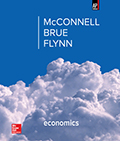
Economics (McConnell), AP* Edition, 20th EditionChapter 35: Financial EconomicsOrigin of the IdeaOrigin of the Idea
The idea that we shouldn’t “put all of our eggs in one basket” has been around for a long time, but it was economist Harry Markowitz who formalized models to determine how best to diversify those “eggs” (our financial wealth) among different “baskets” (the various financial assets available). Basic portfolio theory of the time held, as one might expect, that investors want to maximize their discounted expected return. If this were the only objective, however, the rational investor would put all of his or her financial wealth into a single asset – the one with the highest anticipated return. Markowitz recognized that most investors do not behave this way. He understood that while investors are motivated to maximize returns from their financial investments, they are also aware of and try to minimize risk.
Markowitz introduced variance as a measure of risk. As you may know from the study of statistics (or may soon learn), variance measures how much a variable deviates from its mean (average). In terms of portfolio selection, the mean refers to the average expected return of an asset. Suppose that a particular company stock is expected to increase in value five percent each year. If the variance for that stock is low (at or close to zero), one can rely on the five percent return each year. If the variance is high, that stock might return ten percent one year and negative two percent the next, only averaging out to a five percent return over longer periods of time. At extreme variances, that five percent expected return may simply be the average between a potential huge payoff (well above five percent) and the company going bankrupt, resulting in a total loss for investors. Rather than balancing risk and return over individual assets, Markowitz saw investors balancing over their portfolio. He recognized that different investors have different appetites for returns and tolerance for risk, so the appropriate level of diversification varies across investors. Furthermore, Markowitz recognized that there may be a tradeoff between returns and risk.
One investment rule of the time argued that one could adequately minimize risk and achieve high returns simply by spreading funds across all of the different financial assets with the highest expected rates of return. This rule was based on the “law of large numbers.” This law suggests that with a sufficiently large portfolio of securities, even if a small number fail to deliver the expected returns, others in the portfolio will make up the difference so that the average return for the portfolio as a whole matches the average of the expected returns of the individual assets in the portfolio. Markowitz rejects this rule, claiming that the “returns from securities are too intercorrelated. Diversification cannot eliminate all variance.”(3) This “intercorrelation,” known statistically as covariance, refers to the fact that the returns to a particular asset sometimes are related to the returns of other assets – that fortunes are sometimes tied together. Firms in the same industry, for example, will be subject to the same general market forces. As Markowitz explains,
For his efforts, specifically for his article “Portfolio Selection” that appeared in The Journal of Finance in 1952, Markowitz shared the 1990 Nobel Memorial Prize in Economics (along with Merton Miller and William Sharpe) for “pioneering work in the theory of financial economics.” As explained in the Royal Swedish Academy of Sciences announcement of the prize, “Markowitz’s work on portfolio theory may be regarded as having established financial micro analysis as a respectable research area in economic analysis.” (Press release, Oct. 16, 1990, http://nobelprize.org/nobel_prizes/economics/laureates/1990/press.html) Markowitz was born in Chicago in 1927, where he earned his Bachelor of Arts and Doctoral degrees in economics from the University of Chicago.
|  |















